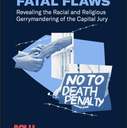A recent editorial in America Magazine entitled The Price of Death reviewed the growing problems with the death penalty and stated, “It is time for the nation to conclude once and for all that in our civilized society there is no place for capital punishment.” The national Catholic weekly cited the recently botched execution in Ohio, racial disparities, and the possibility of executing the innocent as reasons why public support for capital punishment has declined. The editorial also pointed to the high costs of the death penalty as a reason for acting now: “During the current recession, revenue-starved states are looking closely at the cost of capital punishment. According to the nonprofit Death Penalty Information Center in Washington, D.C., death penalty cases typically require huge expenditures, partly because of re-trials to correct prior errors. California’s Commission on the Fair Administration of Justice, for example, has estimated that the state is spending $138 million a year on the death penalty.…Lawmakers, forced by the budget crisis to make cuts in basic services like schools, law enforcement, health care and libraries, must rethink such outlays for capital punishment.”
The magazine said the failed execution of Romell Broom in Ohio raised particular concerns about lethal injection. “It was the third botched execution in the state over the past four years. Yet instead of declaring a moratorium on the practice, Gov. Ted Strickland simply postponed the execution of Mr. Broom and two other condemned men in order to allow officials to revise the protocols for lethal injections. Even in states where executions are carried out as planned, the often grisly circumstances lead some people to wonder why the United States supports the death penalty, one of the few developed countries that still does so.”
Read the entire editorial below:
The Price of Death
The editors | OCTOBER 26, 2009
Public support for capital punishment in the United States has declined in recent years for several reasons, one of which is botched executions. The most recent occurrence was in September in an Ohio prison, where Romell Broom was to be put to death by lethal injection.
Technicians spent two hours attempting to reach a vein on Mr. Broom’s arms and legs before they finally gave up and sent him back to his cell on death row. It was the third botched execution in the state over the past four years. Yet instead of declaring a moratorium on the practice, Gov. Ted Strickland simply postponed the execution of Mr. Broom and two other condemned men in order to allow officials to revise the protocols for lethal injections.
Even in states where executions are carried out as planned, the often grisly circumstances lead some people to wonder why the United States supports the death penalty, one of the few developed countries that still does so.
During the current recession, revenue-starved states are looking closely at the cost of capital punishment. According to the nonprofit Death Penalty Information Center in Washington, D.C., death penalty cases typically require huge expenditures, partly because of re-trials to correct prior errors. California’s Commission on the Fair Administration of Justice, for example, has estimated that the state is spending $138 million a year on the death penalty. For the 670 people on its death row, the state spends $90,000 per inmate per year in addition to the $34,000 annual cost of incarcerating a prisoner serving a life sentence. Death row inmates wait four years on average before being assigned an attorney for their first appeal, which amounts to an added expenditure of $360,000 per inmate even before the appeal is under way. Lawmakers, forced by the budget crisis to make cuts in basic services like schools, law enforcement, health care and libraries, must rethink such outlays for capital punishment.
Meanwhile, the number of executions has dropped. The 37 executions in 2008 mark a 14-year low, underscoring a downward trend that reflects a change in public opinion. Although a Gallup poll last year found that a majority still supports capital punishment, support declined from 69 percent in 2007 to 64 percent in 2008 — a significant contrast with 1994, when 80 percent of Americans supported it. Support drops whenever the alternative is proposed of a life sentence without the possibility of parole. Most polls show that support for such life sentences is about the same as support for the death penalty.
Belatedly proven innocence has become an increasingly important factor in the shift of public opinion. Since 1973, when executions became legal again after a seven-year moratorium, the number of exonerations has risen to 138 — eight of them in this year alone. Most of those exonerated were members of racial minorities; 42 percent of prisoners on death rows around the country are black. Race is a factor in the imposition of the death penalty: studies over the past two decades have shown that people convicted of killing whites were three times more likely to be sentenced to death than those convicted of killing blacks.
Even justices of the U.S. Supreme Court have expressed opposition to capital punishment. Former Justice Harry Blackmun, who in the 1970s voted to allow the death penalty, said just before his retirement in 1994, “I will no longer tinker with the machinery of death.” In 2008 Justice John Paul Stevens called the death penalty “the pointless and needless extinction of life.” And in a speech in 2001 former Justice Sandra Day O’Connor observed that “the system may well be allowing some innocent defendants to be executed.” Consider the case of Cameron Todd Willingham, who was executed in 2004 having set a fire that killed his family; afterward, however, experts found no evidence of arson at his home. In 2002 the Supreme Court ruled on the basis of “evolving standards of decency” that the execution of juveniles violated the Eighth Amendment’s prohibition against cruel and unusual punishment. On the same basis it ruled against executing those with mental retardation. These proactive steps limit the use of the death penalty.
The Catholic Church in the United States has long been opposed to capital punishment. As early as 1980, the U.S. bishops voted to declare their opposition. Pope John Paul II emphasized the universal church’s opposition in his 1995 encyclical Evangelium Vitae. And in a speech at Emory University in Atlanta on Oct. 7, Archbishop Wilton D. Gregory noted that one longstanding argument — that capital punishment serves a deterrent purpose — has been largely discredited by recent studies. It is time for the nation to conclude once and for all that in our civilized society there is no place for capital punishmennt.
(Editorial, “The Price of Death,” America, October 26, 2009). See DPIC’s pages on Romell Broom, Costs and Religion and the Death Penalty.


